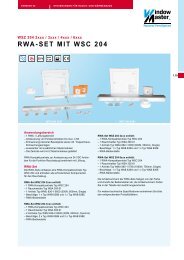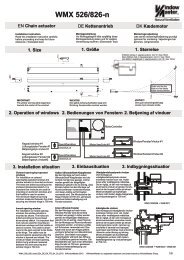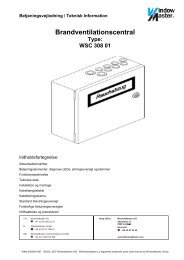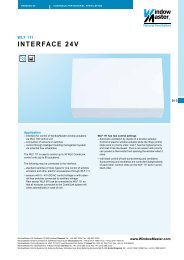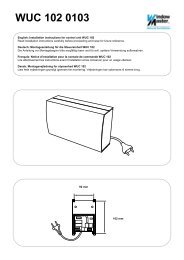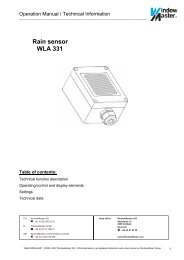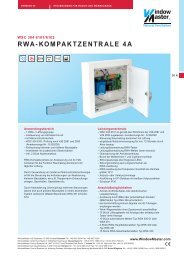ABB i-bus® EIB Universal Interfaces US/U 4.2 US/U ... - WindowMaster
ABB i-bus® EIB Universal Interfaces US/U 4.2 US/U ... - WindowMaster
ABB i-bus® EIB Universal Interfaces US/U 4.2 US/U ... - WindowMaster
You also want an ePaper? Increase the reach of your titles
YUMPU automatically turns print PDFs into web optimized ePapers that Google loves.
<strong>ABB</strong> i-bus ® <strong>EIB</strong><br />
<strong>Universal</strong> <strong>Interfaces</strong><br />
<strong>US</strong>/U 2.2, GH Q631 0074 R0111<br />
<strong>US</strong>/U <strong>4.2</strong>, GH Q631 0070 R0111<br />
Parameter: “Transmit value on each operation”<br />
If “yes” is entered in this parameter, the associated object value is updated<br />
and sent after each operation in the case of multiple push button actions.<br />
Example: For three-fold operations, the objects “Telegr. operation 1-fold”<br />
(after the first operation), “Telegr. operation 2-fold” (after the second operation)<br />
and “Telegr. operation 3-fold” (after the third operation) are sent.<br />
Parameter: “Maximum time between two operations”<br />
This parameter sets the interval between two operations. After an operation,<br />
there is a delay for the duration specified here. If there are no further operations<br />
within this period, the object “Telegr. switch” is sent and the period<br />
restarts after the next operation.<br />
Parameter: “Additional object for long operation”<br />
After a long operation of the input, a further function can be executed via the<br />
object “Telegr. switch-long”. If a long operation is carried out after one or<br />
several short operations within the maximum period, the short operations<br />
are ignored.<br />
Parameter: “Long operation after”<br />
The period is defined here, after which an operation is interpreted as “long”.<br />
Parameter: “Transmitted value”<br />
It can be set here whether the object value “Telegr. switch-long” should be<br />
switched on, switched off or toggled after a long operation.<br />
Parameter: “Debounce time / min. operation time”<br />
The debounce prevents unwanted multiple operation of the input e.g. by<br />
bouncing of the contacts. Refer to section 5.1 for the exact function of this<br />
parameter. A minimum operation time can only be set when there is no<br />
distinction between a short and a long operation.<br />
4.12.2 Communication objects<br />
Objects: “Telegr. operation 1-fold” to “Telegr. operation 4-fold”,<br />
1 bit (EIS 1)<br />
The number of these objects (max. 4) is set in the parameter “Max. number<br />
of operations”.<br />
After multiple operation of an input, the corresponding object is sent<br />
according to the number of operations. The telegram value can be set<br />
in the parameters.<br />
Object: “Telegr. operation-long”, 1 bit (EIS 1)<br />
This object is visible if the value “yes” has been set in the parameter<br />
“Additional object for long operation”.<br />
This object is sent once a long operation has been detected. The telegram<br />
value can be set in the parameters.<br />
36



